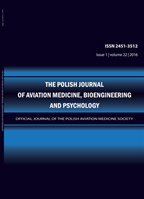2015, Volume 21, Issue 4
Hazard Perception and Anxiety in Novice and Experienced Parachutists
Jan F. TERELAK1, Katarzyna PRZYCHODZKA2
-------------------------------------------------------------------------------------------------
1Military Institute of Aviation Medicine
2Institute of Psychology, Cardinal Stefan Wyszyński University
Autor korenspondencyjny: Jan F. TERELAK; Military Institute of Aviation Medicine; email: jacek.brzezinski[at]wiml.waw.pl
Full text
Streszczenie
Introduction: The article deals with the correlations between hazard perception and anxiety in parachutists.Theoretical background for the study is provided by Eysenck’s theory of personality and Spielberger’s theory of anxiety. Psychological characteristics of parachutists
as a specifi c study population is also provided.
Method: The Impulsivity Inventory (IVE) by Hans J. Eysenck and Sybil B.G. Eysenck measuring three personality features, i.e. impulsiveness, venturesomeness, and empathy was used in the study along with the State-Trait Anxiety Inventory (STAI) by C.D. Spielberger,
R.L. Gorsuch, and R.E. Lushene used to study anxiety as both a state and a trait. The
study was conducted in 64 amateur parachutists (male and female) aged 18 to 60 years,
stratifi ed according to their expertise into novice parachutists (1-50 jumps) and expert
parachutists (more than 50 jumps).
Results: The study demonstrated, among others, that novice parachuters are characterized by an increasingly higher increases in anxiety states as measured by the increase in the
heart rate immediately before the jump. No statistically signifi cant differences were
observed between the study groups with regard to hazard perception, impulsiveness,
empathy, and anxiety as a trait.
Discussion: The article draws attention to anxiety as a state developing in novice parachutists as a result of stress due to the novelty of their situation. In addition, the lack of statistically significant correlations being observed between hazard perception, impulsiveness, empathy, and anxiety as a trait was due to the previous natural psychological selection process.
Conclusions: No statistically significant correlations were observed between hazard perception and anxiety as a trait.
Słowa kluczowe
anxiety as state and trait, hazard perception, impulsiveness, empathy, parachutists
